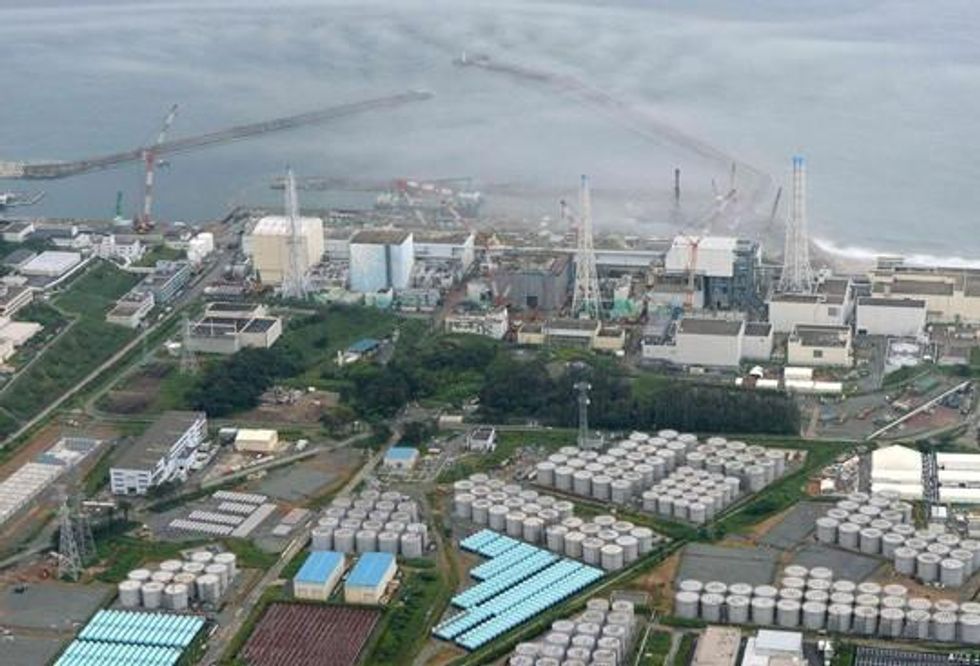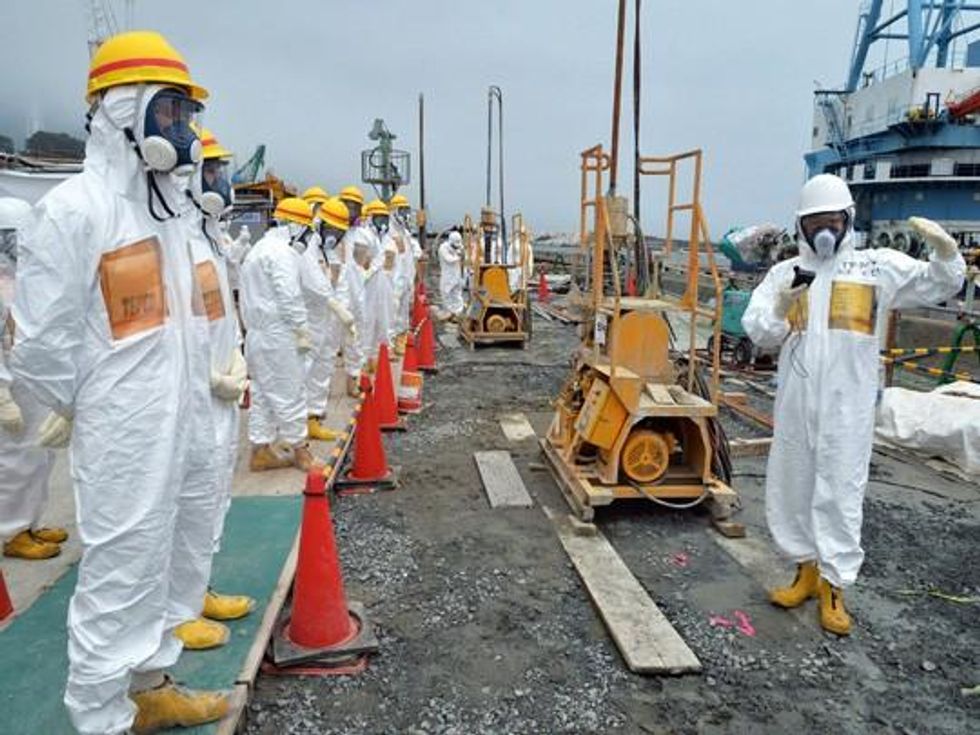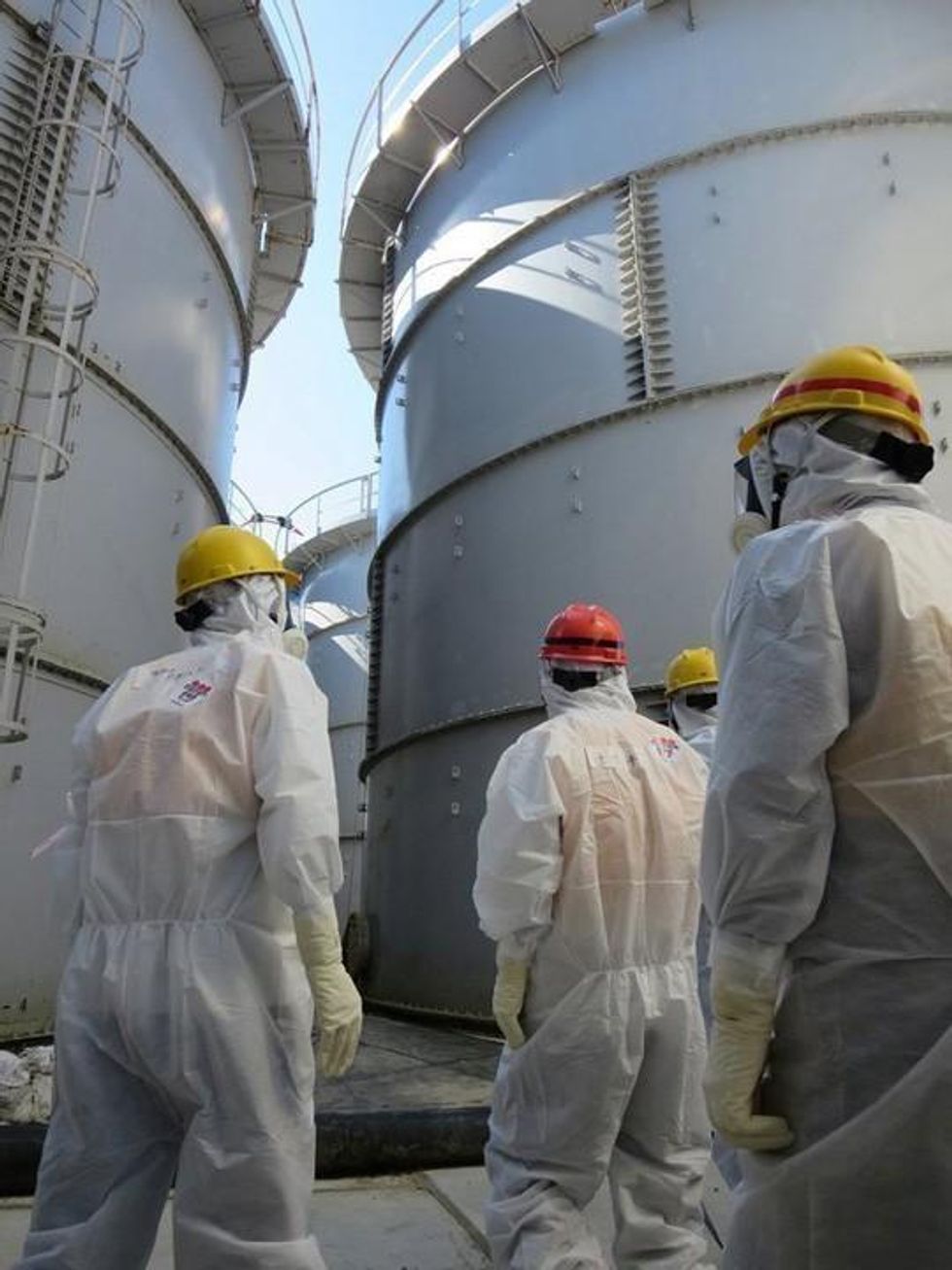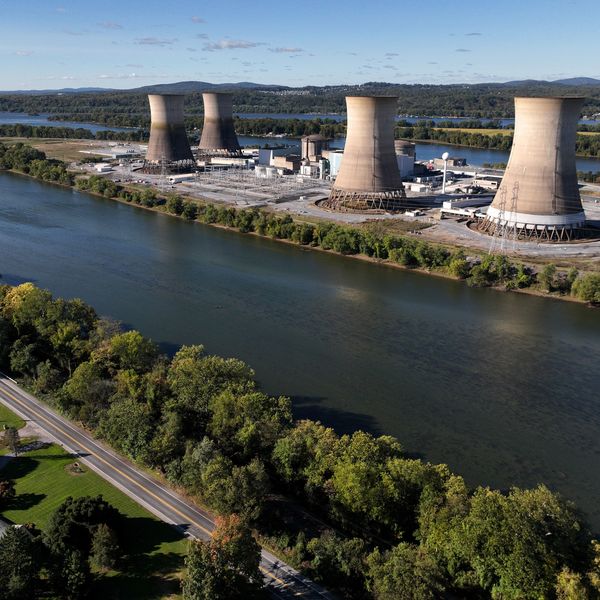Radiation Readings Soar at Leaking Fukushima Nuclear Plant
New leak patched with plastic tape

Radiated water leaking from tanks at Japan's crippled Fukushima nuclear plant is 18 times more dangerous than had been previously reported.
The Tokyo Electric Power Company (TEPCO), which owns the Dai-Ichi Fukushima plant, originally said the radiation emitted by the leaking water was 100 millisieverts an hour.
Now, the company admits, the testing equipment used in the previously announced August 22nd testing could only read measurements of up to a maximum of 100 millisieverts.
Saturday's test, using a more accurate device, showed a level of 1,800 millisieverts an hour, a level that Reuters says is "enough to kill an exposed person in four hours."
In addition, TEPCO announced Sunday that it has discovered a leak on another pipe emitting radiation levels of 230 millisieverts an hour. TEPCO said it halted the leak from a pipe connecting two water storage tanks by patching it with plastic tape just hours after stumbling upon the potentially lethal radioactive hot spot.
Japan Times reports Sunday:
The pipe, which was leaking a drop about every 90 seconds, was sealed using absorption material and plastic tape. A puddle of giving off 230 millisieverts per hour was found below it, TEPCO said.
"We have to suspect that the high radiation levels were caused by the toxic water oozing from the flange connections," a TEPCO spokesman said, adding that no conclusions had been reached.


An Urgent Message From Our Co-Founder
Dear Common Dreams reader, The U.S. is on a fast track to authoritarianism like nothing I've ever seen. Meanwhile, corporate news outlets are utterly capitulating to Trump, twisting their coverage to avoid drawing his ire while lining up to stuff cash in his pockets. That's why I believe that Common Dreams is doing the best and most consequential reporting that we've ever done. Our small but mighty team is a progressive reporting powerhouse, covering the news every day that the corporate media never will. Our mission has always been simple: To inform. To inspire. And to ignite change for the common good. Now here's the key piece that I want all our readers to understand: None of this would be possible without your financial support. That's not just some fundraising cliche. It's the absolute and literal truth. We don't accept corporate advertising and never will. We don't have a paywall because we don't think people should be blocked from critical news based on their ability to pay. Everything we do is funded by the donations of readers like you. Will you donate now to help power the nonprofit, independent reporting of Common Dreams? Thank you for being a vital member of our community. Together, we can keep independent journalism alive when it’s needed most. - Craig Brown, Co-founder |

Radiated water leaking from tanks at Japan's crippled Fukushima nuclear plant is 18 times more dangerous than had been previously reported.
The Tokyo Electric Power Company (TEPCO), which owns the Dai-Ichi Fukushima plant, originally said the radiation emitted by the leaking water was 100 millisieverts an hour.
Now, the company admits, the testing equipment used in the previously announced August 22nd testing could only read measurements of up to a maximum of 100 millisieverts.
Saturday's test, using a more accurate device, showed a level of 1,800 millisieverts an hour, a level that Reuters says is "enough to kill an exposed person in four hours."
In addition, TEPCO announced Sunday that it has discovered a leak on another pipe emitting radiation levels of 230 millisieverts an hour. TEPCO said it halted the leak from a pipe connecting two water storage tanks by patching it with plastic tape just hours after stumbling upon the potentially lethal radioactive hot spot.
Japan Times reports Sunday:
The pipe, which was leaking a drop about every 90 seconds, was sealed using absorption material and plastic tape. A puddle of giving off 230 millisieverts per hour was found below it, TEPCO said.
"We have to suspect that the high radiation levels were caused by the toxic water oozing from the flange connections," a TEPCO spokesman said, adding that no conclusions had been reached.



Radiated water leaking from tanks at Japan's crippled Fukushima nuclear plant is 18 times more dangerous than had been previously reported.
The Tokyo Electric Power Company (TEPCO), which owns the Dai-Ichi Fukushima plant, originally said the radiation emitted by the leaking water was 100 millisieverts an hour.
Now, the company admits, the testing equipment used in the previously announced August 22nd testing could only read measurements of up to a maximum of 100 millisieverts.
Saturday's test, using a more accurate device, showed a level of 1,800 millisieverts an hour, a level that Reuters says is "enough to kill an exposed person in four hours."
In addition, TEPCO announced Sunday that it has discovered a leak on another pipe emitting radiation levels of 230 millisieverts an hour. TEPCO said it halted the leak from a pipe connecting two water storage tanks by patching it with plastic tape just hours after stumbling upon the potentially lethal radioactive hot spot.
Japan Times reports Sunday:
The pipe, which was leaking a drop about every 90 seconds, was sealed using absorption material and plastic tape. A puddle of giving off 230 millisieverts per hour was found below it, TEPCO said.
"We have to suspect that the high radiation levels were caused by the toxic water oozing from the flange connections," a TEPCO spokesman said, adding that no conclusions had been reached.



